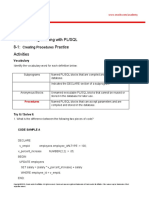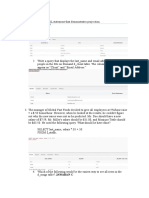Database Programming With SQL 10-4: Correlated Subqueries Practice Activities
Database Programming With SQL 10-4: Correlated Subqueries Practice Activities
Uploaded by
Ralu-ArdeleanCopyright:
Available Formats
Database Programming With SQL 10-4: Correlated Subqueries Practice Activities
Database Programming With SQL 10-4: Correlated Subqueries Practice Activities
Uploaded by
Ralu-ArdeleanOriginal Title
Copyright
Available Formats
Share this document
Did you find this document useful?
Is this content inappropriate?
Copyright:
Available Formats
Database Programming With SQL 10-4: Correlated Subqueries Practice Activities
Database Programming With SQL 10-4: Correlated Subqueries Practice Activities
Uploaded by
Ralu-ArdeleanCopyright:
Available Formats
Database Programming with SQL
10-4: Correlated Subqueries
Practice Activities
Objectives
• Identify when correlated subqueries are needed
• Construct correlated subqueries
• Construct named subqueries using the WITH clause
Try It / Solve It
1. Explain the main difference between correlated and non-correlated subqueries?
2. Write a query that lists the highest earners for each department. Include the last_name,
department_id, and the salary for each employee.
SELECT e.last_name, e.department_id, e.salary
FROM employees e
WHERE e.salary = (SELECT MAX(ee.salary) FROM employees ee WHERE e.department_id = ee.department_id)
3. Examine the following select statement and finish it so that it will return the last_name,
department_id, and salary of employees who have at least one person reporting to them. So we
are effectively looking for managers only. In the partially written SELECT statement, the WHERE
clause will work as it is. It is simply testing for the existence of a row in the subquery.
SELECT outer.last_name, outer.department_id, outer.salary
FROM employees outer
SELECT (enter columns here) WHERE outer.employee_id IN (SELECT DISTINCT inner.manager_id
FROM (enter table name here) outer FROM employees inner
WHERE 'x' IN (SELECT 'x' WHERE inner.manager_id = outer.employee_id)
ORDER BY outer.department_id
FROM (enter table name here) inner
WHERE inner(enter column name here) = inner(enter column name here)
Finish off the statement by sorting the rows on the department_id column.
4. Using a WITH clause, write a SELECT statement to list the job_title of those jobs whose maximum
salary is more than half the maximum salary of the entire company. Name your subquery
MAX_CALC_SAL. Name the columns in the result JOB_TITLE and JOB_TOTAL, and sort the
result on JOB_TOTAL in descending order.
Hint: Examine the jobs table. You will need to join JOBS and EMPLOYEES to display the
job_title. WITH MAX_CALC_SAL AS
(SELECT j.job_id , j.job_title, MAX(e.salary) AS job_actual_max FROM employees e
RIGHT OUTER JOIN jobs j ON e.job_id = j.job_id GROUP BY j.job_id,j.job_title)
SELECT job_title, job_actual_max AS job_total
FROM max_calc_sal
WHERE job_actual_max > (SELECT MAX(job_actual_max)/2 FROM max_calc_sal)
ORDER BY job_total DESC
Copyright © 2020, Oracle and/or its affiliates. All rights reserved. Oracle and Java are registered trademarks of Oracle and/or its affiliates. Other names may be trademarks of their respective owners.
You might also like
- Lesson 1 Case Character Manipulation Answer GuideDocument5 pagesLesson 1 Case Character Manipulation Answer GuideDamayanti100% (4)
- DP 4 3 Solution PDFDocument5 pagesDP 4 3 Solution PDFJessica IreneNo ratings yet
- Oracle Database Programming - Section 4Document6 pagesOracle Database Programming - Section 4Angga WijayaNo ratings yet
- Homework Week #1 PL/SQL Virtual Training: PL/SQL SQL PL/SQL SQL PL/SQL SQLDocument3 pagesHomework Week #1 PL/SQL Virtual Training: PL/SQL SQL PL/SQL SQL PL/SQL SQLmonica_lufoNo ratings yet
- PLSQL s07 l02 AppexDocument4 pagesPLSQL s07 l02 Appexalfonz100% (1)
- SQL Test PaperDocument5 pagesSQL Test PaperSreekanth KeesaraNo ratings yet
- MS SQL Server Interview QuestionsDocument17 pagesMS SQL Server Interview QuestionsAnilkumar000100% (4)
- DP 7 1 Practice Ethan VijuDocument5 pagesDP 7 1 Practice Ethan VijuAbhay Kumar Sharma BOODHOONo ratings yet
- Practice 18 Adding Additional Pages To Your ApplicationDocument24 pagesPractice 18 Adding Additional Pages To Your ApplicationthirumuruganNo ratings yet
- DP - 14 - 1 - Practice FAZRULAKMALFADILA - C2C022001Document4 pagesDP - 14 - 1 - Practice FAZRULAKMALFADILA - C2C022001Fazrul akmal fadhilaNo ratings yet
- Database Programming With SQL 6-3: Inner Versus Outer Joins Practice ActivitiesDocument4 pagesDatabase Programming With SQL 6-3: Inner Versus Outer Joins Practice ActivitiesHumphreyNo ratings yet
- DP - 15 - 1 - Practice FAZRULAKMALFADILA - C2C022001Document3 pagesDP - 15 - 1 - Practice FAZRULAKMALFADILA - C2C022001Fazrul akmal fadhilaNo ratings yet
- DP 4 2 PracticeDocument2 pagesDP 4 2 PracticeAlexandru CristianNo ratings yet
- Database Programming With SQL 2-1: Working With Columns, Characters, and Rows Practice ActivitiesDocument14 pagesDatabase Programming With SQL 2-1: Working With Columns, Characters, and Rows Practice ActivitiesMinul MirdhaNo ratings yet
- Database Programming With SQL 2-3: Comparison Operators Practice ActivitiesDocument2 pagesDatabase Programming With SQL 2-3: Comparison Operators Practice Activitiesstenly94No ratings yet
- Database Programming With SQL 2-3: Comparison Operators Practice ActivitiesDocument8 pagesDatabase Programming With SQL 2-3: Comparison Operators Practice ActivitiesMinul MirdhaNo ratings yet
- This Study Resource Was: Database Programming With PL/SQL 9-3: Practice ActivitiesDocument2 pagesThis Study Resource Was: Database Programming With PL/SQL 9-3: Practice ActivitiesGilang SaputraNo ratings yet
- Database Programming With PL/SQL 8-1: Practice Activities: Creating ProceduresDocument5 pagesDatabase Programming With PL/SQL 8-1: Practice Activities: Creating ProceduresSameer HmedatNo ratings yet
- Homework Week 5Document4 pagesHomework Week 5Dragoș JidveanNo ratings yet
- 2022 - 3 - Prakddp - Tugas 12 - 12D2 - 211210041 - Hildegardis Kristina SakaDocument19 pages2022 - 3 - Prakddp - Tugas 12 - 12D2 - 211210041 - Hildegardis Kristina Sakadhea ferdiana merpatika100% (1)
- Database Programming With PL/SQL 8-1: Practice Activities: Creating ProceduresDocument5 pagesDatabase Programming With PL/SQL 8-1: Practice Activities: Creating ProceduresSameer HmedatNo ratings yet
- PLSQL 5 2 PracticeDocument5 pagesPLSQL 5 2 PracticeANONYMOUSHELPINGOTHERSNo ratings yet
- Ref CursorDocument2 pagesRef Cursormohd127No ratings yet
- Practice CompletaDocument3 pagesPractice CompletaEmanuel G.No ratings yet
- Database Programming With SQL 2-2: Limit Rows Selected Practice ActivitiesDocument3 pagesDatabase Programming With SQL 2-2: Limit Rows Selected Practice Activitieschristian tombilayukNo ratings yet
- Database Programming With SQL Section 17 Quiz Part IIDocument47 pagesDatabase Programming With SQL Section 17 Quiz Part IIJosé Obeniel LópezNo ratings yet
- DP 4 1 Practice Completed PDFDocument4 pagesDP 4 1 Practice Completed PDFJessica IreneNo ratings yet
- DP 1 3 PracticeDocument2 pagesDP 1 3 PracticeDanaNo ratings yet
- DD 9 1 Solution PDFDocument3 pagesDD 9 1 Solution PDFJessica IreneNo ratings yet
- DP 4 3 PracticeDocument3 pagesDP 4 3 PracticeNiiaNo ratings yet
- DP 3 2 PracticeDocument7 pagesDP 3 2 PracticeJessica IreneNo ratings yet
- DD 8 2 PracticeDocument4 pagesDD 8 2 PracticeArsil KarimNo ratings yet
- DP - 14 - 3 - Practice FAZRULAKMALFADILA - C2C022001Document5 pagesDP - 14 - 3 - Practice FAZRULAKMALFADILA - C2C022001Fazrul akmal fadhilaNo ratings yet
- Database Programming With SQL 3-3: Introduction To Functions Practice SolutionsDocument2 pagesDatabase Programming With SQL 3-3: Introduction To Functions Practice SolutionsAlNo ratings yet
- Database Programming With PL/SQL 6-1: Practice Activities: Introduction To Explicit CursorsDocument4 pagesDatabase Programming With PL/SQL 6-1: Practice Activities: Introduction To Explicit CursorsMohammad RawashdehNo ratings yet
- Database Programming With PL/SQL 6-2: Practice Activities: Indexing Tables of RecordsDocument2 pagesDatabase Programming With PL/SQL 6-2: Practice Activities: Indexing Tables of RecordsАбзал КалдыбековNo ratings yet
- Database Programming With PL/SQL 3-4: Practice Activities: Using Transaction Control StatementsDocument3 pagesDatabase Programming With PL/SQL 3-4: Practice Activities: Using Transaction Control StatementsBogdan BicaNo ratings yet
- This Study Resource Was: Database Programming With PL/SQL 3-4: Practice ActivitiesDocument3 pagesThis Study Resource Was: Database Programming With PL/SQL 3-4: Practice ActivitiesFernanda CoronadoNo ratings yet
- BDII Tema03Document8 pagesBDII Tema03Marius Iulian100% (1)
- Practice PLSQL SEC 4Document19 pagesPractice PLSQL SEC 4annonymous100% (1)
- DP 1 3 PracticeDocument4 pagesDP 1 3 PracticeJessica IreneNo ratings yet
- Quiz 5Document7 pagesQuiz 5Emanuel G.0% (1)
- PLSQL 2 2 PracticeDocument3 pagesPLSQL 2 2 PracticelilianaNo ratings yet
- PLSQL 3.1 EdDocument5 pagesPLSQL 3.1 Ed¿Jhovan?No ratings yet
- PLSQL 07 01 Handling ExceptionsDocument5 pagesPLSQL 07 01 Handling ExceptionsZachary MillerNo ratings yet
- A Ref Cursor Is A VariableDocument3 pagesA Ref Cursor Is A Variablerajeswar9No ratings yet
- PLSQL 2 5 PDFDocument30 pagesPLSQL 2 5 PDFsiwNo ratings yet
- DocxDocument8 pagesDocxAlfonso Torres100% (1)
- PDF PLSQL 2 7 Practice CompressDocument2 pagesPDF PLSQL 2 7 Practice CompressFernanda CoronadoNo ratings yet
- Assessment PL-SQLDocument13 pagesAssessment PL-SQLAditya Kurre100% (1)
- Kunci JavaDocument16 pagesKunci JavaFebry RamadanNo ratings yet
- PLSQL 3 1 AssessmentDocument3 pagesPLSQL 3 1 AssessmentRei TupazNo ratings yet
- SQL Schema ERD and Table DesignsDocument8 pagesSQL Schema ERD and Table DesignsMiruna ScobanNo ratings yet
- SQL - Practice AssignmentsDocument3 pagesSQL - Practice AssignmentsJaganathan SekarNo ratings yet
- Database Design 8-4: Drawing Conventions For Readability Practice ActivitiesDocument3 pagesDatabase Design 8-4: Drawing Conventions For Readability Practice ActivitiesArsil KarimNo ratings yet
- lab-SQL Exo CorrigésDocument57 pageslab-SQL Exo CorrigésKarim AlamiNo ratings yet
- Database Programming With SQL 10-4: Correlated Subqueries Practice ActivitiesDocument1 pageDatabase Programming With SQL 10-4: Correlated Subqueries Practice ActivitiesFlorin CatalinNo ratings yet
- MLS Week 3-SolutionDocument8 pagesMLS Week 3-SolutionSunil SharmaNo ratings yet
- Join, Subqueries and Set Operators - 1Document60 pagesJoin, Subqueries and Set Operators - 1shylender.mumadiNo ratings yet
- R T - SQL: Ecuperación DE Datos DE Varias AblasDocument37 pagesR T - SQL: Ecuperación DE Datos DE Varias AblasAngel LimachiNo ratings yet
- Single-Row SubqueriesDocument12 pagesSingle-Row SubquerieskishuNo ratings yet
- Section 2Document6 pagesSection 2Sebassssd100% (1)
- Unit4 GisOperationAndMapCompositionDocument33 pagesUnit4 GisOperationAndMapCompositionBhosadi WalaNo ratings yet
- SQL - Quick GuideDocument163 pagesSQL - Quick GuideKavya MamillaNo ratings yet
- Puan HawanisDocument15 pagesPuan HawanisAnis HidayahNo ratings yet
- Exam DBU F17 SolutionDocument14 pagesExam DBU F17 SolutionFrederik JørgensenNo ratings yet
- Sample ManualDocument62 pagesSample ManualleninishaNo ratings yet
- What Is Mutating Trigger?: Test Empno Test 1001Document24 pagesWhat Is Mutating Trigger?: Test Empno Test 1001shNo ratings yet
- ML - AI RoadmapDocument14 pagesML - AI Roadmapsanot31159No ratings yet
- MSSQLDocument46 pagesMSSQLEdward RuppeeNo ratings yet
- Oracle QuestionsDocument114 pagesOracle Questionsrishi5354No ratings yet
- SAP HANA Modeling Guide For SAP HANA XS Advanced Model en V1.0 SPS12Document86 pagesSAP HANA Modeling Guide For SAP HANA XS Advanced Model en V1.0 SPS12hana89No ratings yet
- Learn FileMaker Pro 19 The Comprehensive Guide to Building Custom Databases Second Edition Mark Conway Munro 2024 scribd downloadDocument55 pagesLearn FileMaker Pro 19 The Comprehensive Guide to Building Custom Databases Second Edition Mark Conway Munro 2024 scribd downloadvancewetta2i100% (3)
- ECSE - CBP FinalDocument17 pagesECSE - CBP Finalmittupathuri83No ratings yet
- Aziz Sheikh ResumeDocument2 pagesAziz Sheikh Resumesheikhaziz2949No ratings yet
- Oracle SQL TutorialDocument66 pagesOracle SQL TutorialArnaldo JrNo ratings yet
- Sr. ETL Kafka Developer 5 Years, Arumugam P - AXO2370 - AugmntXDocument2 pagesSr. ETL Kafka Developer 5 Years, Arumugam P - AXO2370 - AugmntXrajendrasNo ratings yet
- Database Programming With PL/SQL: Introduction To Explicit CursorsDocument11 pagesDatabase Programming With PL/SQL: Introduction To Explicit CursorsBinibini Shane0% (1)
- Connection PoolingDocument5 pagesConnection PoolingFaizan QaziNo ratings yet
- Python Application Programming (15CS664) : Question Bank For The SubjectDocument3 pagesPython Application Programming (15CS664) : Question Bank For The SubjectHeenaNo ratings yet
- 09-02-24 Single Row Function, Null, NVL FunctionDocument4 pages09-02-24 Single Row Function, Null, NVL Functiondillipkumarchoudhury78No ratings yet
- C Programming with Database: Speaker: Guo-Heng Luo (羅國亨)Document10 pagesC Programming with Database: Speaker: Guo-Heng Luo (羅國亨)NierNo ratings yet
- Yarakala Sandeep Goud E-Mail:-Mobile: - +91 - 8885453887 Location: HyderabadDocument4 pagesYarakala Sandeep Goud E-Mail:-Mobile: - +91 - 8885453887 Location: Hyderabadtelugu latest job notifications jobsNo ratings yet
- Practical - 7 Creating Template in Writer: File Templates SaveDocument23 pagesPractical - 7 Creating Template in Writer: File Templates Savestudy.kataria.lakshya08No ratings yet
- Database Design Project: Oracle Baseball League Store DatabaseDocument2 pagesDatabase Design Project: Oracle Baseball League Store DatabaseMD MEHEDI HASAN A20MJ4005No ratings yet
- SQL Data TypesDocument3 pagesSQL Data TypesRamyaVijayaraghavanNo ratings yet
- Mohammed Yahya Sarayi Dallas, Texas SummaryDocument5 pagesMohammed Yahya Sarayi Dallas, Texas Summarykiran2710No ratings yet
- Oracle e Business Suite Release 12.2 FeaturesDocument39 pagesOracle e Business Suite Release 12.2 Featuressuicide_kingNo ratings yet
- MDX TutorialDocument50 pagesMDX TutorialMichel PierreNo ratings yet
- VinPlus Installation Guidelines - Rev01Document13 pagesVinPlus Installation Guidelines - Rev01Vishwanath TodurkarNo ratings yet

























































































